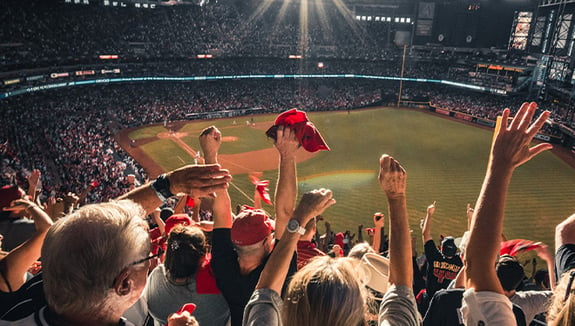Covid-19 is keeping fans and brands at a physical distance. Yet there are huge opportunities for organisations who understand how to use data to connect and engage with their consumers in these unprecedented times.
One way in which brands can gain a full view of each and every consumer and as a result, find new and compelling insights is by going cashless. Working with sports and entertainment brands around the globe and particularly in the USA, we have seen a huge increase in interest around cashless solutions that can help fill in the missing pieces that help brands completely understand their consumer and bring them closer than ever.
How can consumer data strengthen the bond between customer and brand?
The value of targeted and personalised marketing cannot be understated when it comes to getting customers to engage with your brand. Whether you push tailored offers through a brand’s app or you use a loyalty program to incentivise purchases, using consumer data to speak directly to individuals helps to develop a closer relationship with your brand.
Engagement coupled with adoption of new systems (like cashless payments) will in turn deliver loyalty and revenue. And the good news is – it’s not that difficult to achieve. However, gaining access to all the customer insights and data is essential, and this is what comes with choosing the right cashless technology. Once you have the data and the insights, you can really start to build that fan loyalty.
So, why is loyalty so important?
Put simply, loyalty drives revenue.
The stats speak for themselves. If you ensure your customers feel a sense of loyalty, the business value increases in terms of length of relationship and share of spend.
- A 5% increase in customer retention correlates with at least a 25% increase in profit. (Bain & Company)
- A business’ top 10% of customers spend 3x more than the average customer. (Adobe)
- Your chance of selling to an existing customer is 60-70%, while your chance of selling to a brand new customer is 5-20%. (Marketing Metrics)
- Customers with an emotional relationship with a brand have a 306% higher lifetime value and will recommend the company at a rate of 71%, rather than the average rate of 45%. (Motista)
And it’s easy to get there.
The first step to creating loyalty is to actually understand your customer. If you don’t know their habits and preferences, it makes it impossible to reward loyalty and increase engagement. If you don’t have that data then you’re stuck at step one, and no amount of customer surveys and focus groups will change that.
Cashless payment systems offer the best consumer data available
If organisations choose their cashless solution correctly, not only can they minimise the risk of Covid-19, but they can help ensure the sustainability of their business. The data collected from cashless systems delivers a view into operational efficiencies, increases consumer spending and most importantly, enables a full view of each and every customer.
And this is where the true value lies. Purely by going “contactless” (i.e. using a bank to deliver your payment) rather than seeking out “cashless” solutions, organisations lose out on incredibly valuable data.
Finding a way to engage customers, create a safe way to pay and keep them immersed in your own digital ecosystem is nirvana for all forward thinking marketers and businesses. In particular, the most engaged organisations are focused on white label mobile pay solutions. A white label mobile pay solution sits seamlessly in brands’ own apps and ensures that customers engage for longer with brands and can have the full 360 experience of entering a venue or store, getting the latest news and offers, being rewarded for their purchases and behaviours and being able to make payments.
The most important part is the fact that by embedding mobile pay into your solution, you can truly understand your consumer through data around purchasing, behaviours and preferences – which enables you to create engagement opportunities and loyalty – which in turn drives revenue.
Lastly, reward and encourage your audience in ways that matter to them.
So you need to have “step one” firmly in place. For example, would someone who parks in the parking lot and buys Pepsi at a game every week be interested in beer promotions? Unlikely. Imagine if you could reach out to them and offer them an additional Pepsi or snack if they came down to the venue a bit earlier instead of their usual arrival 30 mins before the game – information you also can gather from parking data.
You have fans and customers that appreciate the offers they’re sent. The communication is relevant, it adds value to their experience and what’s more, you’re tailoring offers in a way that helps grow your business. The result is increased loyalty, engagement and revenue. It’s the perfect solution to the battle for consumers’ spend and eyeballs.
There are some great examples of who is using cashless and mobile pay to drive adoption and loyalty. Until recently, Starbucks was the most successful mobile pay wallet in the world, beating Apple Pay and Google Pay. Now brands including Walmart and Chick-Fil-A are enabling people to purchase within their mobile apps. This means that businesses bring their consumers closer, understand them more and reward them for loyalty – it’s the perfect scenario.



COMMENTS